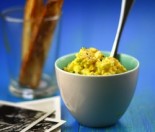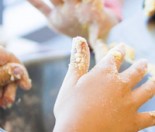Learning is something that we humans are programmed to do. We arrive helpless and dependent but wired to acquire language, and anyone who’s ever lived with a toddler for more than five minutes will recognise the relentless desire to explore, touch, taste, and be amazed by life.
Some people manage to retain that ferocious enthusiasm for learning all their lives. Many of us have it beaten out of us, often by the very system that is trying so hard to ‘educate’ us. Maybe that’s because it turns learning into a competition, in which only a few can win. The rest learn, alas, that they’re ‘not very good’ at things like maths, or science, or languages, or whatever else it is that they don’t come top of the class in. Fortunately an increasing number of educators round the world are beginning to realise that learning shouldn’t be a competitive sport – partly because competitive sports generate a lot of spectators! Unfortunately, we have a way to go yet before everyone catches up with that idea.
In the meanwhile, what can we do to make learning the integral part of human life that it really is? Like many things, home is a good place to start – for one thing, it’s usually a place where you can follow your nose, make a few mistakes, and not get into too much trouble (burning the kitchen down in home-made science experiments may not fit that definition, but most learning experiences don’t have such dire consequences!). In many ways, the hardest thing to do is to stop children learning when they’re given some spare time and a bit of encouragement. As many wise people have noted, boredom is a great spur to subsequent activity, so leaving kids to get bored isn’t necessarily a bad thing. They’ll be a lot more enthusiastic about doing things once they’ve mooned about for a while.
The immediate response here is likely to be “But they don’t get bored, they play computer games all day!” This is certainly an issue in modern society, but as has been pointed out, even computer games aren’t all bad – they teach a lot of skills, even if they’re not the ones parents might expect, and certainly give the lie to the theory that modern kids have no concentration span. Ever watched a team of teenage lads playing a computer game for hours on end? They probably wouldn’t notice if World War 3 broke out around them. And they do become awfully handy at fixing general computer issues that their parents can’t even begin to cope with. The main issue is interrupting that kind of learning to ensure that a bit of balance is inserted into their lives.
There is a lot of concern in our modern, pressured society that people haven’t learned some basic survival skills that used to be taken for granted – like basic housekeeping, gardening and cooking, and crafts like cooking, sewing, woodwork and metalwork. It might be surprising to stop and think that in fact, the dreaded Internet is starting to do quite a lot to remedy this – there are all sorts of sites, dedicated to teaching people skills from scratch. They are often set up by people who do it out of the goodness of their hearts because they love the things they do and want to share them. If you look, just for a few minutes, you’ll find people teaching you how to knit, how to paint, how to build your own cob cottage, how to keep chickens, how to make marmalade, how to clean your kitchen with the aid of baking soda and white vinegar, how to grow your own vegetables on the patio in a tenth-floor apartment. You name it, you’re likely to find it. And of course, parents need to be there to provide guidance, because there are also a lot of people who are keen to teach things that no-one in their right mind would want their children to learn, but that just goes with the territory of being a parent.
One of the main positives about learning in this way is that no-one is judging you. You can muck about with whatever it is, ask for help from others (online or at home) if you need it, and quietly throw your disasters away without needing to expose them to public view. All the while, learning is happening and experience is being gained.
In a society where it is finally being realised that a lot of commercially-prepared foods are doing our health no good, one of the best places to start learning is in the kitchen. Not only do kids learn that they can make tasty fresh food that is good for them and their family; they also rapidly learn that it’s much cheaper than the bought stuff, so some basic economics is soaking in as well. And they can show off their newfound skills to their friends and family, and get them involved as well, spreading the learning even further. Maybe granny’s recipe book, with the stained entries labelled “Mrs Wrigley’s gingerale cake – delicious” and “Joan’s meat loaf – economical and tasty” is just being replaced by Emily’s baking blog and Matt’s home-made salami page on Facebook.
Just to get started, you might like to get together with the kids and try some really simple recipes like these:
Sunflower, sesame and pesto crackers
Ham and Cheese (or Corn and Cheese) Croquettes
These are delicious! The recipe as provided is gluten free, but you can of course just substitute ordinary flour instead of rice flour and use ordinary cornflakes or breadcrumbs to coat them.
Ingredients
- 4 medium potatoes (preferably Agrias), peeled, cooked and mashed with no added butter or oil (that comes later)
- 60g butter
-
¼ cup fine white rice flour, plus an extra ½ cup for coating the croquettes
-
1 cup milk
-
1 ½ cups grated tasty cheese
-
1 cup chopped ham OR 1 cup sweet corn kernels, lightly cooked
-
1 small onion, finely chopped
-
¼ cup finely chopped flat-leaf parsley
-
2 eggs, lightly beaten
-
2 cups crushed gluten-free cornflakes or dry gluten-free breadcrumbs
-
Vegetable oil for shallow frying
Method
Melt the butter in a saucepan over medium heat and add the onions. Cook, stirring occasionally, until the onions are soft.
Add the ¼ cup of rice flour and stir to mix well.
Remove from heat and gradually whisk in the milk.
Return to the heat and cook, stirring continually, until the mix boils and thickens.
Remove from the heat and add the potato, cheese, ham or sweetcorn, and parsley.
Chill for about 30 minutes in the fridge.
Line an oven tray with baking paper.
Divide the mix into about 10 or 12 even-sized lumps and shape each into a small log.
Place the extra flour, the beaten egg and the cornflakes/breadcrumbs into separate plates.
Roll each log in rice flour, then dip in egg and finally roll in crushed cornflakes/crumbs.
Place each log on the prepared tray and chill in the fridge for about 15 minutes.
Heat cooking oil in a large frying pan over high heat and shallow fry the croquettes in batches for about 2-3 minutes or until golden brown all over.
Serve with salad and if you like it, try sweet chilli sauce as an accompaniment. Plum sauce is also a possibility.
Thai Chicken lettuce Cups
Again, these are slightly modified from an online recipe. The recipe is inherently gluten free and these are really delicious, as well as being good for you!
Ingredients
- 1 large head iceberg lettuce
- 3 Tbsp vegetable oil
- 1 large onion, chopped (red or white onions, whichever you prefer)
- 1 Tbsp finely chopped fresh ginger
- 2 cloves garlic, finely chopped
- 600-800g chicken mince (the amount isn’t critical, so whatever you can get in this range is fine)
- 1 ½ Tbsp gluten-free soy sauce
- 1 Tbsp fish sauce (this smells nasty but really contributes a great flavour, oddly enough. This is a mild dose – if you are a fish sauce fan, feel free to double it)
- ¼ cup brown sugar
- 2 tsp lime zest
- 2 Tbsp freshly squeezed lime juice
- ½ tsp red pepper flakes (optional! If you don’t like red pepper flakes, leave them out)
- 2large spring onions, finely sliced
- ½ cup chopped fresh coriander (or parsley if you and coriander don’t like one another)
- ¼ cup chopped fresh mint
- ¼ cup chopped cashews or peanuts
Optional For Serving:
- Finely sliced carrots
- Lime wedges
- Coriander/parsley and/or mint sprigs
Method
- Fill a large bowl with cold water. Cut off the lettuce stem then cut round the inner core so you can remove it. Discard the scruffy, leathery outer leaves, the place the lettuce in the bowl of water. Gently pull apart the leaves, then remove them and dry them. Chill in the fridge until ready to serve.
- Heat the oil in a large pan over medium heat. Add the onion and ginger and cook, stirring frequently, until soft, 4-5 minutes. Add the garlic and cook 1 minute more.
- Add the chicken mince and turn the heat up to high. Cook, stirring constantly, until partially cooked through (about 3 minutes). Add the soy sauce, fish sauce, brown sugar, lime zest, lime juice and red pepper flakes and continue cooking, stirring frequently to break up the meat, until the chicken is cooked through (probably 6-10 minutes more). Stir in the spring onions, coriander/parsley, mint and nuts and remove from the heat.
- Taste and adjust seasoning if necessary. Spoon into lettuce cups and serve with optional garnishes. The easiest way to eat them is to roll them up and eat with your fingers. Really tasty!
Home-made nut butters
These are great! You do need a food processor to achieve them, but if you don’t have one, go and talk nicely to a friend who does. In exchange for half your nut butter, they’ll probably be very happy to oblige…
General proportions: 2 cups of raw nuts (almonds, cashews, brazil nuts, peanuts, or whatever mixture you like best, including macadamias if you’re lucky enough to have some) plus ½ tsp salt (don’t be tempted to add more – it isn’t nice!).
Dry-roast the nuts in a large metal tray in the oven at about 160°C for 20 minutes, turning once during the process. Allow to cool slightly, so that you can handle them but they are still warm, then transfer to a food processor. Whizz for about a minute, then scrape down the processor and whizz for another minute. Once you have a fine crumb, add a teaspoon or two of light olive oil or other mild, good quality cooking oil and process again. It may take about five minutes in total to get a buttery mix. For a while, it may look way too stiff and very unappealing. Just keep going – there is a fairly abrupt change to a smooth, much less stiff mix. Add more oil very cautiously if needed.
Store the mix in a glass jar and fend off those who just want a bit more…
This recipe will make enough to fill a normal-sized glass peanut butter jar (around 280-300ml).
Zucchini cakes with citrus icing
And because the zucchini season is approaching… These are really good – not too sweet and nicely spiced. You can indeed use medium-sized marrows for this if the zucchinis have got away on you; no-one will know!
Ingredients
-
1 ¾ cups flour
-
¾ tsp baking soda
-
1 tsp baking powder
-
1 tsp cinnamon
-
1 tsp cardamom
-
3 eggs
-
1 cup sugar
-
Finely grated rind of 1 orange or tangelo or lemon, plus the juice (used in the icing)
-
½ cup rice bran or light olive oil
-
2 loosely packed cups of grated zucchini or modestly-sized marrow
-
2 Tbsp poppy seeds
For the icing:
-
¾ cup icing sugar
-
2-4 Tbsp citrus juice
Method
Preheat the oven to 180°C.
Line a muffin tin with cupcake cases.
Place flour, soda, baking powder, cinnamon and cardamom in a bowl and combine.
Beat eggs and sugar until thick and pale, then add the citrus rind and drizzle in the oil while still beating the mix.
Add zucchini and poppy seeds to the wet mix and combine.
Add the wet mix to the flour and mix thoroughly.
Divide between the 12 cake cases.
Bake 20-30 minutes or until a skewer comes out clean.
Cool completely before icing.
Have fun learning, learning in the kitchen and making the most of the summer produce available. Enjoy!









